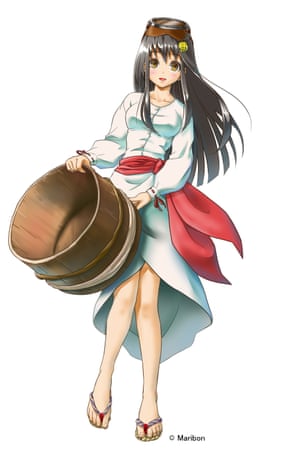Next year’s G7 summit in the Japanese city of Shima has already been hit by controversy. However, the row is not over policy, but over the meeting’s official mascot, Aoshima Meg – a manga rendering of a teenage girl dressed as one of the area’s famed ama divers.
The city dropped the mascot last week after it had been denounced as sexist and an insult to the female divers – many of whom are in their 60s and 70s – who traditionally dive for pearls and abalone without breathing apparatus.
But that has not been the only recent manga row. There was barely a murmur of disapproval when Japan’s prime minister, Shinzo Abe, announced that his country would not be taking in Syrian refugees. It was left to a pitiless manga depiction of a six-year-old Syrian girl to ignite public debate. The illustration drew loud protests on social media and prompted a change.org campaign demanding that the artist, Toshiko Hasumi, remove it from her Facebook page.
The furores underlined manga’s capacity to attract controversy and provoke debate in Japan, where just about everyone has, at some time, delved into a manga comic, book or weekly magazine serialisation. The books alone generate a domestic market worth 280bn yen (£1.5bn).
Mass-market titles such as Doraemon, featuring a robot cat popular with children, and Golgo 13, the adventures of a professional assassin which has sold more than 200m copies since its release in the late 1960s, share shelf space with an array of specialist titles that take on taboo subjects.
Manga’s capacity to shock was highlighted again last month when the UN envoy on child protection, Maud de Boer-Buquicchio, called on Japan to ban sexually abusive images of children, amid resistance from authors and publishers who say the move would threaten freedom of expression.
Manga is probably Japan’s most versatile form of narrative fiction, according to Dan Kanemitsu, a manga translator, covering everything from care for the elderly, multicultural identities and gender issues to poverty and even rural depopulation. Many authors, Kanemitsu said, “employ the medium of manga to explore many difficult issues facing Japan today. While titles that provide casual entertainment are legion, there is no shortage of titles that concern themselves with numerous social issues.”
The medium – one of Japan’s most successful pop-culture exports – has drawn inspiration from some of the most divisive issues of recent times, from the health effects of the Fukushima nuclear disaster to Japan’s testy relations with South Korea.
Patrick Galbraith, author of The Otaku Encyclopedia: An Insiders Guide to the Subculture of Cool Japan, points to the gekiga (dramatic pictures) genre, which addressed the human cost of war and economic recovery in 1960s Japan, as a shining example of daring manga of the kind that have reappeared in the aftermath of the Fukushima meltdown. “Manga was, and continues to be, gutsy in ways that put other media to shame,” Galbraith said.
It also explores topics that most journalists and writers prefer to avoid. “Even the subject of the [Japanese] imperial household can become the object of humour and satire,” said Kanemitsu. “While no commercial publisher will touch a manga that makes fun of the emperor, they do exist and are circulated through alternative distribution channels.”
Even Osamu Tezuka, considered the doyen of manga artists, made room in his eclectic portfolio for difficult subjects, while at the same time publishing mass-market series for children and adults. Perhaps best known outside Japan for Astro Boy, Tezuka also broached the horrors of Nazi concentration camps and nuclear holocaust.
“Since the end of the second world war and the lifting of censorship restrictions, manga has been a platform for confronting and grappling with social and political taboos,” said Roland Kelts, the author of Japanamerica: How Japanese Pop Culture Has Invaded the US. “This is partly because manga still flies slightly below the radar. Mainstream public discourse is comparatively more muted and discreet. In this context manga is more like punk music.”
Manga has been among the victims of Japan’s political drift to the right under Abe. Two years ago, authorities in the city of Matsue provoked an outcry after it ordered the removal of the anti-war comic Hadashi no Gen (Barefoot Gen) from school libraries. Critics labelled Keiji Nakazawa’s work “defeatist” for its criticism of the wartime emperor, Hirohito, and its graphic illustrations of atrocities committed by the Japanese imperial army.
Several years ago, Japan’s troubled relations with its neighbours inspired a wave of nationalist manga, includingKenkanryu, whose unsympathetic depictions of Koreans and their culture drew allegations of racism.
Japan’s polarised political scene, coupled with rising regional tensions and challenging domestic issues such as depopulation and the role of women, should generate ample material to cement manga’s place in the public discourse.
“Traditionally, Japanese manga artists have been cutting edge,” said Brian Ashcraft, a Japan-based contributor to the video game site Kotaku. “For decades, they’ve dealt with a wide variety of social issues, such as identity politics and sexuality, in heartfelt, progressive and engaging ways. Not all manga has taken a smart, nuanced approach to these issues, but just like in the west, not all art does that either.”
Experts say there has always been a gap in the market for manga that tackles political issues, from Japan’s prewar experiment with militarism to Abe’s controversial security bills.
“Manga are so diverse that there are even titles about the ‘ageing society’ problem, gay lives and rights, the ‘comfort women’ and war responsibility, pretty much any issue of social importance,” said Matthew Penney, an assistant professor at Concordia University in Montreal, who specialises in popular representations of war in Japan.



Không có nhận xét nào:
Đăng nhận xét